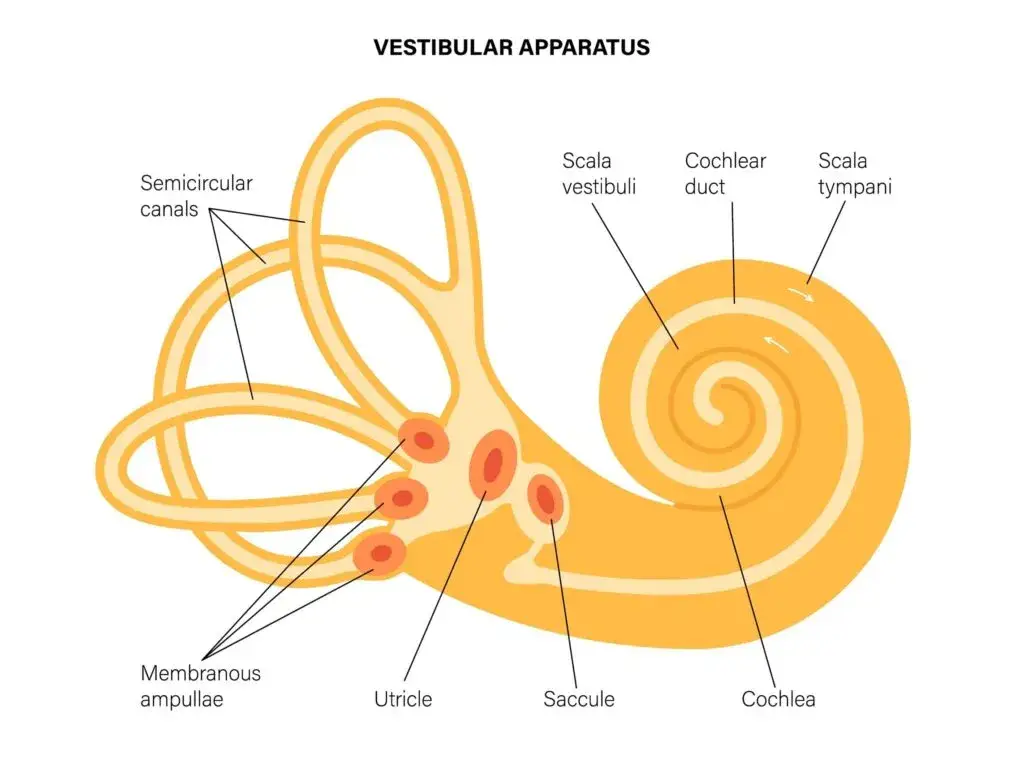
Why Doesn’t the Epley Maneuver Work for Me? Vertigo is one of the most disorienting sensations a person can experience. The world spins, your balance disappears, and even the simplest tasks become challenging. For many, the Epley Maneuver is the first treatment they try after being diagnosed with Benign Paroxysmal Positional Vertigo (BPPV) — and while it can help some, it doesn’t work for everyone.
If you’ve tried the Epley Maneuver with little to no success, you’re not alone. Many people continue to struggle with dizziness, imbalance, and that persistent feeling of motion even after performing it perfectly. The truth is, vertigo isn’t always as simple as “ear crystals out of place.” Sometimes, the root cause lies in your upper neck, not your inner ear.
At Lavender Family Chiropractic in Sarasota, Florida, we specialize in finding and correcting the root neurological cause of vertigo, dizziness, and balance disorders through Upper Cervical Chiropractic Care — a precise and gentle approach that restores the proper communication between your brain and body.
Let’s dive deeper into why the Epley Maneuver doesn’t always work and how correcting your upper cervical spine could be the missing link in your recovery.
Understanding Vertigo and Why Doesn’t the Epley Maneuver Work for Me?
What Is Vertigo?
Vertigo is not a diagnosis — it’s a symptom. It’s the false sense that you or your surroundings are spinning or moving. While many people associate vertigo with inner ear issues, it can also be caused by problems in the cervical spine, vestibular system, or central nervous system.
Vertigo can range from mild and brief to severe and chronic. Some people feel dizzy only when changing positions (like rolling over in bed), while others feel as if they’re constantly on a boat.
How the Epley Maneuver Works
The Epley Maneuver is designed to treat BPPV, the most common cause of vertigo. In BPPV, tiny calcium crystals called otoconia become dislodged from their proper chamber in the inner ear and move into the semicircular canals, where they interfere with fluid movement and send false signals to the brain.
The Epley Maneuver is a series of head and body movements meant to reposition those crystals back into their correct place. When done correctly, it can provide almost immediate relief — but only if BPPV is truly the problem.
Why the Epley Maneuver Fails for So Many People
If the Epley Maneuver didn’t work for you, it doesn’t necessarily mean it was done incorrectly. In many cases, the Epley doesn’t address the actual cause of the problem.
Here are the top reasons why the Epley Maneuver might not work — and what may really be happening underneath.
1. Misdiagnosis: Not All Vertigo Is BPPV
One of the biggest misconceptions about vertigo is that it’s always caused by inner ear crystals. In reality, BPPV accounts for only a portion of vertigo cases. Many patients who are told they have BPPV actually suffer from other conditions, such as:
- MdDS (Mal de Débarquement Syndrome) – Persistent rocking or swaying sensations after being on a boat or plane.
- Cervicogenic Vertigo – Dizziness originating from dysfunction in the upper cervical spine.
- Vestibular Neuritis or Labyrinthitis – Inflammation of the inner ear.
- Meniere’s Disease – A chronic vestibular disorder involving fluid buildup in the inner ear.
- Central Vertigo – Caused by problems in the brain or brainstem.
If your vertigo is coming from nerve interference or spinal misalignment, no amount of head tilting will fix it — because the problem isn’t in your ear. It’s in the communication between your brainstem and body.
2. The Root Cause Is in the Neck — Not the Ear
Your upper cervical spine (the top two bones in your neck) plays a critical role in balance and spatial orientation. These vertebrae — called the Atlas (C1) and Axis (C2) — protect the brainstem, which acts as the communication hub between your brain, vestibular system, and body.
When these bones become misaligned, even slightly, they can cause irritation or compression of the nerves and brainstem. This can disrupt your body’s ability to interpret balance signals accurately, leading to vertigo, dizziness, and unsteadiness.
At Lavender Family Chiropractic, we see this connection every single day. Many of our patients come to us after months (or years) of trying Epley maneuvers, medications, or vestibular therapy with little improvement. Once we identify and correct the misalignment at the top of their neck, their vertigo begins to fade — often for good.
3. The Epley Doesn’t Address Nervous System Interference
Balance is not just mechanical — it’s neurological. Your vestibular system works in tandem with your eyes, muscles, and spinal cord to keep you upright and oriented. This delicate balance is controlled by constant feedback through the brainstem.
If your upper cervical spine is misaligned, it can interfere with that feedback loop, causing chronic dizziness, lightheadedness, and a sense of motion even when you’re still.
The Epley Maneuver simply repositions ear crystals; it does nothing to address neurological communication errors caused by spinal imbalance. Until that interference is corrected, the brain will continue to misinterpret balance signals.
4. You May Have Multiple Vestibular Disorders
It’s also possible that you’re dealing with more than one vestibular issue. For example, some people have mild BPPV combined with cervicogenic vertigo, or a lingering vestibular neuritis that weakens their balance system.
In those cases, the Epley may relieve one part of the problem but leave the underlying dysfunction unresolved — which is why your symptoms keep returning.
5. Lingering Trauma or Whiplash
Even a small car accident, sports injury, or fall can lead to subtle but lasting misalignments in the upper cervical spine. These injuries can distort how your brain perceives motion and equilibrium.
It’s not uncommon for us to see patients who developed vertigo weeks or months after an accident, never realizing their neck trauma was the real culprit. The Epley Maneuver can’t correct a mechanical injury to the spine — but Upper Cervical Chiropractic Care can.
How Upper Cervical Misalignment Causes Vertigo
Your body’s sense of balance depends on clear, synchronized information from three major systems:
- The Vestibular System (inner ear)
- The Visual System (eyes)
- The Proprioceptive System (muscles and joints, especially in the neck)
When your upper neck — the Atlas and Axis — are out of alignment, they distort the signals traveling between these systems and the brainstem. This leads to a sensory mismatch, where your brain receives conflicting information about your position in space.
That mismatch triggers symptoms such as:
- Spinning sensations
- Rocking or swaying
- Lightheadedness
- Motion sensitivity
- Difficulty focusing
- Head pressure
- Nausea
By gently realigning the upper cervical spine, we restore proper communication between the brain and body. The result? Your nervous system can recalibrate — and your balance returns naturally.
What Is Upper Cervical Chiropractic Care?
When most people think of chiropractic care, they picture twisting, cracking, and popping — but Upper Cervical Chiropractic Care is completely different. It’s a precise, gentle, and science-based form of chiropractic that focuses exclusively on the top two bones in your neck — the Atlas (C1) and Axis (C2). These vertebrae protect the most vital part of your nervous system: the brainstem.
The brainstem is the body’s control center. It regulates balance, coordination, blood pressure, heart rate, breathing, and many involuntary functions you don’t even think about. When the Atlas or Axis are even slightly out of alignment, it can interfere with how your brain communicates with the rest of your body — leading to a wide range of symptoms like vertigo, dizziness, migraines, fatigue, and imbalance.
At Lavender Family Chiropractic in Sarasota, Florida, our doctors specialize in detecting and correcting these subtle yet powerful misalignments through gentle, precise, and customized upper cervical adjustments.
The Importance of the Atlas and Axis
Your Atlas and Axis are unlike any other bones in the spine. They allow your head to move freely — nodding, turning, and tilting — while also protecting the lower part of the brainstem and upper spinal cord. Because of this unique anatomy, they are also more prone to misalignment from even minor injuries, poor posture, or repetitive stress.
When these vertebrae shift out of position, the effects can be far-reaching:
- Neurological interference: The brainstem can’t properly send or receive messages to the body.
- Blood flow disruption: The vertebral arteries that supply blood to the brain can be compressed or irritated.
- Muscle imbalance: The neck and surrounding muscles tighten and compensate for the misalignment.
- Vestibular dysfunction: The brain misinterprets balance signals, leading to dizziness, vertigo, and motion sensitivity.
This is why someone can experience vertigo, headaches, neck pain, or even fatigue and brain fog — all stemming from an upper cervical problem. The source is small, but the impact is massive.
How Upper Cervical Chiropractic Differs from Traditional Chiropractic
While traditional chiropractic care often focuses on the entire spine, Upper Cervical Chiropractic zeroes in on the most neurologically significant area — the upper neck. Instead of forceful manual adjustments, upper cervical doctors use gentle and specific corrections designed to realign the spine without twisting or popping.
Here’s what makes this approach unique:
- Precision over force: Adjustments are based on 3D imaging and exact measurements.
- Gentle corrections: There’s no cracking or torque. Patients often describe the adjustment as feeling like light pressure.
- Neurological focus: The goal is to restore communication between the brain and body, not just relieve pain.
- Lasting change: Once the alignment is corrected, the body can maintain balance and healing over time, reducing the need for frequent adjustments.
At Lavender Family Chiropractic, we use advanced technology like 3D CBCT imaging and Tytron functional nervous system scans to see exactly how your upper neck alignment is affecting your health.
Our Advanced Technology: CBCT and Tytron Scans
3D CBCT Imaging
We use Cone Beam Computed Tomography (CBCT) to get a crystal-clear, three-dimensional image of your upper cervical spine. This allows us to identify the exact direction and degree of misalignment — something traditional X-rays simply can’t do. The CBCT scan helps us visualize your bone structure in remarkable detail, ensuring that every adjustment is tailor-made to your anatomy.
Tytron Functional Nervous System Scans
The Tytron scanner measures thermal and neurological imbalances along your spine, revealing areas where nerve interference is occurring. These scans give us real-time insight into how your body is functioning and how well your brainstem is communicating with your body. We use these scans before and after adjustments to track progress and confirm that your nervous system is healing as expected.
How an Upper Cervical Adjustment Works
Every upper cervical adjustment is based on a blueprint of your individual misalignment. Using the detailed information from your CBCT scans, your doctor will deliver a gentle and specific correction to your Atlas or Axis — no popping, cracking, or twisting.
This adjustment releases pressure from the brainstem, allowing your nervous system to restore balance and normal function. Once that interference is removed, the body’s natural healing mechanisms can finally work the way they were designed to.
Many patients notice improvements not only in vertigo and dizziness, but also in:
- Neck stiffness and pain
- Migraines and chronic headaches
- Fatigue and “brain fog”
- Ear fullness or tinnitus
- POTS and autonomic dysfunction
- Balance and coordination
- TMJ or jaw tension
Because the adjustment targets the root cause, the results are often long-lasting and life-changing.
Upper Cervical Chiropractic and Vertigo
Vertigo and dizziness are among the most common symptoms we see in our office. Most patients have tried medications, Epley maneuvers, or vestibular therapy — only to have the symptoms return again and again. That’s because in many cases, the true problem isn’t in the ear, but in the upper neck.
When the Atlas shifts out of alignment, it can distort how the brain interprets signals from the inner ear and eyes. This creates a constant state of confusion in your nervous system — you feel like you’re spinning, even though you’re not.
Correcting the misalignment rebalances those signals, allowing the brain to accurately perceive motion, position, and stability again. Many of our vertigo patients report that after their first few upper cervical adjustments, the spinning sensation drastically decreases, and their confidence in movement returns.
The Healing Process
Healing takes time — especially when the nervous system has been under stress for months or years. After the initial correction, your body begins to unwind old compensation patterns, and your nervous system starts to recalibrate.
You may experience changes in posture, muscle tension, sleep quality, and even digestion. These are signs that your body is reorganizing and adapting to its new alignment.
At Lavender Family Chiropractic, we closely monitor your progress using follow-up scans and evaluations to ensure that your body is holding its correction. Our goal is not just to make you feel better temporarily — it’s to help your body hold alignment naturally, so you can stay balanced, healthy, and symptom-free long term.
Conditions We Commonly See Improve with Upper Cervical Care
Many patients come to Lavender Family Chiropractic after trying everything else — from ENT visits and vestibular therapy to medications and Epley maneuvers. Once we correct the spinal misalignment affecting their brainstem, the improvements can be remarkable.
Common conditions that respond well include:
- Vertigo (BPPV, MdDS, Cervicogenic Vertigo, Meniere’s)
- Chronic Dizziness or Lightheadedness
- Head Pressure and Ear Fullness
- Tinnitus (Ringing in the Ears)
- Neck Pain and Stiffness
- Migraines and Tension Headaches
- POTS and Autonomic Dysfunction
- Jaw Pain (TMJ Disorders)
- Fibromyalgia and Fatigue
Why Choose Lavender Family Chiropractic
Located at 5899 Whitfield Ave Ste 107, Sarasota, FL 34243, our office has helped hundreds of patients throughout Sarasota, Bradenton, Lakewood Ranch, Parrish, Ellenton, Venice, Osprey, Siesta Key, Longboat Key, and St. Petersburg overcome debilitating dizziness and vertigo.
We are proud to be known as the best upper cervical chiropractors in Sarasota and Manatee County, offering a combination of advanced imaging, neurological testing, and compassionate care that’s unmatched in the region.
We don’t just adjust your neck — we restore your hope, your stability, and your quality of life.
Real Results from Real Patients
Many of our patients share similar stories:
“I tried the Epley Maneuver over and over, thinking it was just ear crystals. Nothing worked until I saw Dr. Lavender. After my first few adjustments, the spinning stopped completely. I finally felt steady again.”
“After years of dizziness and misdiagnosed BPPV, Lavender Family Chiropractic found that my atlas was misaligned from a car accident years ago. Once it was corrected, my balance came back and my headaches disappeared.”
These are not rare miracles — they’re the natural result of correcting the true source of the problem.
Frequently Asked Questions About Vertigo and Upper Cervical Chiropractic
1. Why does vertigo happen even when I’m not moving?
Because your brain is receiving conflicting signals about your position. When your upper neck is misaligned, it can confuse your balance centers, making you feel motion even when still.
2. Can I have BPPV and a neck misalignment at the same time?
Yes. Many patients do. Correcting the neck alignment often helps prevent BPPV from returning.
3. How do I know if my vertigo is coming from my neck?
If your symptoms worsen with neck movement, posture changes, or after a neck injury, there’s a high likelihood that your cervical spine is involved.
4. Is Upper Cervical Chiropractic safe?
Absolutely. Our adjustments are extremely gentle and precise — safe for all ages, including seniors and those with previous neck injuries.
5. Can this help with MdDS (Mal de Débarquement Syndrome)?
Yes. MdDS is often connected to brainstem dysfunction and abnormal sensory integration, which upper cervical care can help restore.
6. What technology do you use?
We use 3D CBCT scans for exact spinal mapping and Tytron thermal scans for nervous system analysis.
7. Does insurance cover care?
Our office is out of network with insurance, but many patients receive a superbill to submit for reimbursement. We also offer flexible payment and financing options.
8. How long will it take to feel better?
Some patients feel relief after their first few adjustments, while others require several weeks. It depends on the severity and duration of your misalignment.
9. Will I need lifelong adjustments?
Our goal is to restore stability, not dependency. Once your spine holds its correction, we move you into wellness visits to maintain your progress.
10. What is the difference between Upper Cervical Chiropractic and traditional chiropractic?
Traditional chiropractic often focuses on the entire spine and uses manual adjustments with popping and twisting. Upper Cervical Chiropractic focuses solely on the top two vertebrae, using precise imaging and gentle corrections.
11. Can upper cervical adjustments help ear pressure or fullness?
Yes. Many patients experience relief from ear fullness, popping, or crackling after their alignment is corrected.
12. Do you help with migraines and headaches too?
Absolutely. Misalignment at the upper neck is one of the leading causes of migraines and tension headaches.
13. How do I schedule an appointment?
Call (941) 243-3729 or visit www.chiropractorsarasotaflorida.com to schedule a consultation.
14. What makes Lavender Family Chiropractic different?
We combine the most advanced imaging, cutting-edge technology, and personalized care with a deep commitment to finding the true cause of your symptoms.
15. What should I expect at my first visit?
You’ll receive a full consultation, 3D CBCT imaging, functional nerve scans, and a customized plan for restoring your balance and health.
The Bottom Line: The Epley Isn’t the Whole Story
The Epley Maneuver can be a helpful tool — but only if BPPV is the true cause of your vertigo. If it hasn’t worked for you, it’s time to look deeper. Your dizziness may be rooted in upper cervical misalignment, affecting how your brain and body communicate.
At Lavender Family Chiropractic, we’ve helped countless patients who were told to “just live with it” finally find lasting relief — not by treating symptoms, but by restoring balance to their nervous system.
If you’ve tried everything and still feel dizzy, off-balance, or frustrated, you don’t have to keep searching. The solution could be just above your shoulders.
Call Today to Find Out if Upper Cervical Care Can Help You
📞
🌐 www.chiropractorsarasotaflorida.com
📍 5899 Whitfield Ave Ste 107, Sarasota, FL 34243
Lavender Family Chiropractic in Sarasota Florida offers complimentary consultations to learn more about you. Click the link below!
https://intake.chirohd.com/new-patient-scheduling/724/lavender-family-chiropractic
Visit our Website!
To learn more about us go to http://www.chiropractorsarasotaflorida.com
We also service Bradenton, Parrish, Ellenton, Ruskin, Venice, Tampa, St. Pete, Osprey, Longboat, Lakewood Ranch, Myakka City.
If you are in Tampa, Fort Myers, or Salt Lake City, you can visit my other locations! NeckWise Upper Cervical. Visit, www.neckwise.com
If you are not local, visit www.uccnearme.com to find a doctor in your area
Serving Sarasota, Bradenton, Lakewood Ranch, Parrish, Ellenton, Venice, Osprey, Siesta Key, Longboat Key, Lido Key, Myakka City, and St. Petersburg, Florida.
Let’s help you finally stop spinning — and start living again.
Would you like me to expand this further into a 5000-word version with additional sections on MdDS, Cervicogenic Vertigo, and Vestibular Dysfunction for stronger SEO and patient education?



